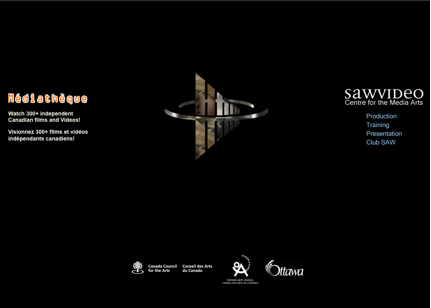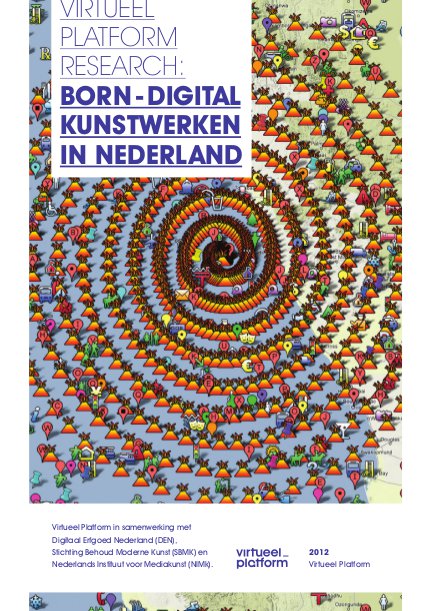Mélanie Hogan: Crashing the Archive: A Research-Creation Intervention into the SAW Video Mediatheque (2012)
Filed under thesis | Tags: · archive, archiving, preservation, storage, video art

“Video Cache is a research creation intervention emerging from my doctoral research into defunct and crashed online archives, in the context of Canadian video art, which has a rich history of self-preservation and of documenting itself as an art movement. From major art galleries to personal collections; Canada has long privileged video as a tool for creative resistance, expression, and experimentation. Video Cache serves to track the SAW Video Mediatheque (based in Ottawa), from its launch to its crash and back online again, by updating its context and addressing in a practical way what it means to ‘activate’ the online archive. Much of my intervention occurred after the crash and during the two years the site was offline. It involved varied methodological entry points including in depth interviews with SAW Video staff and media archaeology to locate digital traces of the site. Key here is Video Cache’s success in simultaneously documenting the project and intervening to address archival loss: while it was the ‘cache’ that made the Mediatheque’s traces visible and re-visit-able, it was the ‘crash’ that signalled its ongoing archival value.” (from Abstract)
PhD thesis
Department of Communication Studies, Concordia University, Montréal, Québec, Canada
April 2012
Virtueel Platform: Born-Digital Kunstwerken in Nederland (2012) [Dutch]
Filed under book | Tags: · archive, archiving, born-digital art, digital art, internet art, media art, net art, netherlands

Born-digital kunst maakt een steeds groter deel uit van Nederlandse kunstcollecties. Omdat born-digital kunst andere eisen stelt aan beheer en behoud dan fysieke kunstcollecties, is er behoefte aan meer inzicht in de huidige praktijk en de obstakels die zich daarbij voordoen.
Enkele Nederlandse organisaties die zich bezighouden met deze vraagstukken, Virtueel Platform, Digitaal Erfgoed Nederland (DEN), Stichting Behoud Moderne Kunst (SBMK) en Nederlands Instituut voor Mediakunst (NIMk), hebben gezamenlijk gewerkt aan een onderzoek naar deze specifieke problematiek.
Zij zijn in april 2012 gezamenlijk een nieuw initiatief gestart voor digitale kunst: het Dutch Art Force.
Het onderzoek inventariseert hoeveel born-digital kunstwerken in de collecties aanwezig zijn en beschrijft in welke mate beheer en behoud geregeld zijn. Het resultaat is een aanzet tot een heldere probleemstelling, vergezeld van aanbevelingen.
Tevens is onderzocht of aansluiting op een bestaand internationaal netwerk mogelijk is, of dat een dergelijk netwerk tussen verschillende partijen opgezet moet worden. Het is duidelijk dat de musea met veel vergelijkbare vragen en problemen zitten bij het verzamelen, beheren en presenteren van born-digital kunst.
Daarnaast wordt er door kunstenaars en andere, vaak producerende, organisaties aan interessante oplossingen gewerkt. Hoewel er verschillende belangen spelen, vinden de partijen elkaar in de gedeelde overtuiging van de noodzaak dat er op korte termijn actie ondernomen moet worden om het hedendaagse cultureel erfgoed voor de toekomst veilig te stellen.
Research and text by Annet Dekker
Research assistant: Marleen Wagenaar
Publisher: Virtueel Platform, in collaboration with Digitaal Erfgoed Nederland (DEN), Stichting Behoud Moderne Kunst (SBMK), and Nederlands Instituut voor Mediakunst (NIMk), April 2012
Creative Commons BY-NC License
100 pages
PDF
View online (Isuuu.com)
Charles Merewether (ed.): The Archive (2006)
Filed under book | Tags: · archive, archiving, art, art history, history, identity, memory, museum, theory

“In the modern era, the archive—official or personal—has become the most significant means by which historical knowledge and memory are collected, stored, and recovered. The archive has thus emerged as a key site of inquiry in such fields as anthropology, critical theory, history, and, especially, recent art. Traces and testimonies of such events as World War II and ensuing conflicts, the emergence of the postcolonial era, and the fall of communism have each provoked a reconsideration of the authority given the archive—no longer viewed as a neutral, transparent site of record but as a contested subject and medium in itself.
This volume surveys the full diversity of our transformed theoretical and critical notions of the archive—as idea and as physical presence—from Freud’s “mystic writing pad” to Derrida’s “archive fever”; from Christian Boltanski’s first autobiographical explorations of archival material in the 1960s to the practice of artists as various as Susan Hiller, Ilya Kabakov, Thomas Hirshhorn, Renée Green, and The Atlas Group in the present.”
Publisher Whitechapel, London, and MIT Press, 2006
Documents of Contemporary Art series
ISBN 0262633388, 9780262633383
207 pages
Reviews: Sas Mays (caa.reviews 2009), Barbara Beckers (Incirculation 2012).
PDF (13 MB, updated on 2016-8-8)
Comments (8)
